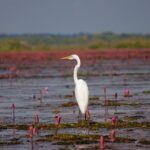
In the book Ignited Minds, APJ Abdul Kalam talks about interaction with school children. Talking to a student in middle school he became thoughtful. The student asked why can’t India take water from here in Assam which is in excess and transfer it to Rajasthan where there is little water for people? The former President was stunned and thought quite deeply about how wonderful an engineering marvel would it be if India could indeed build a canal-like that. Maybe for good or worse no one took the plan of the child very seriously but the problem of water scarcity in India is such that the government and its people have to do much more than just build a big canal to solve it.
According to a NITI Aayog report on “water management index” 2018, India is currently suffering from the worst water crisis in its history with the country ranked at 120 among 122 countries in the quality of water. By 2020, it said, as many as 21 major cities of India will run out of the water and face ‘day zero’— a term that got popular after a major water crisis in Cape Town in South Africa, which means switching off most of the city’s tap for a day. The report further said 600 million people face high-to-extreme water stress, 75% of households do not have drinking water on-premises and 84% rural households do not have access to piped water.[1]
In the “WWF Water Risk Filter” Report Two Indian cities — Jaipur (45th) and Indore (75th) — featured. The WWF report named 28 more Indian cities, which it said will face “increasing water risks in the next few decades”[2]
The world took note when Cape Town in South Africa ran out of the water but even back home a similar fate was met by India’s 6th largest city Chennai 2019 when the city’s reservoirs dipped to a historic low. Located on a flood plain, the city had paved over the lakes and wetlands that might have helped the process of recharging the water table. As a result, heavy rains couldn’t percolate into aquifers under the city. Water pooled and surged aboveground. That reduced the resources available to deal with a crisis like that. [3]
More than 90% of the urban population has had access to ‘basic water’ since 2005, but only one-third of India’s wastewater is currently treated, leading to the high burden of water-borne diseases like cholera and typhoid which puts a large number of lives in jeopardy. Recently severe health risks engulfed Delhi’s population when ammonia in the Yamuna shot up quite substantially.
There are also other issues like the rural-urban divide. While urban water access is high on average, significant gaps remain across the country, and wastewater treatment remains stuck at the national average of ~33%. Most states report a high percentage of urban population having access to drinking water, except for the North-Eastern and Eastern regions, with Bihar, Jharkhand, Assam, and Nagaland reporting less than half of the urban population having access.
In addition to health and environmental risks, there are severe gender and social dynamics to the problem as well. Women and marginalised sections have to put in extra effort to get water. In few places in UP, for instance, the tanker sent as a relief to villages only serves the upper caste while Dalits are socially segregated from using the same water. [4] P. Sainath in his book “Everyone Loves a Good Drought” had also talked about the political connections of the water mafia in the state of Tamil Nadu which also further aggravates the problem for the poor.
The Government Response
Over the last few decades, India has made large investments in water infrastructure (estimated at Rs 350-400 per capita annually under various schemes), ~Rs 430 billion under JNNURM (Jawaharlal Nehru Urban Renewal Mission), ~Rs 200 billion under Smart Cities, ~Rs 80 billion under AMRUT and Rs 50-100 billion each year for NRDWP (National Rural Drinking Water Programme). Although the country has benefitted from these investments, the coverage remains poor. A long list of policies and schemes have been formulated which needs to be taken a greater look at.
The Modi Government has decided to shift its focus from Jan Dhan and Ujjwala scheme to water-based schemes in its second term in office or so it seems. The government under
“Nal se Jal” has made an ambitious target of providing tap water connection to every household by 2024.[5] The scheme has an added advantage of complementing other government schemes like Swacchh Bharat to improve rural sanitation cover. The scheme is also supposed to aid in improving the Government’s target of doubling farmer’s income by 2022-23. All these seem brilliant but there are some severe constraints attached to it.
Do we as a nation have the necessary reservoirs of water? Reservoir levels in drought-hit Marathwada are below 2%. In the rest of the country, reservoir levels have plummeted to an all-time low and in several states, the Central Water Commission admits, they are well below 10% during some parts of the year.
Visakhapatnam-based water activist Satyanarayana Bolisetty said, “Such a scheme will enrich a handful of contractors without addressing the key issue which is that the water tables in our country must be increased. To do so, we have to go back to our traditional practices of water conservation – which means we stop encroachments along our riverbanks, lakes and wetlands. This, in turn, means strict action against the land mafia.[6]
Some of the models that the ministry has reviewed exist in Telangana and Bihar, where a monthly or an annual fee is charged from households for providing piped water.
The Mission Bhagiratha launched in 2016, the scheme aims to provide piped water connection to 20 lakh households in urban and 60 lakh households in rural areas of Telangana. While households falling below the poverty line have to pay Re 1 a month to get piped water supply, the fee is Rs 100 for other households. But even that had certain drawbacks like the water being supplied had high pollutant content. The economic feasibility of such a plan can also be questioned as traditional methods of water conservation in the hamlets of Rajasthan made more economic sense than piped water connection.
“The Gramin Peyjal Yojana” in Bihar, also launched in 2016, proposes to provide all households in 4,291-gram panchayats clean drinking water supply through community participation by 2019-2020. In all, 2 crore households will be provided clean drinking water facilities. Those from below poverty line households have to pay a monthly fee of Rs 30 for the piped water supply, while the rest have to pay Rs 60 per month.
The Jal Shakti Abhiyan, a time-bound mission mode water conservation campaign to be carried out in two phases in 255 districts, having critical or overexploited groundwater levels. This campaign was not intended to be a funding programme and did not create any new intervention on its own. It only aimed to make water conservation a people’s movement through ongoing schemes like MGNREGA and others.
The JSA portal claims impressive data like 10 million ongoing and water conservation structures, planting of one billion saplings and the participation of around 6 million people making it a mass movement. However, the data is scanty since it does not speak of pre-JSA water level and the impact of monsoon on it. To measure the overall impact of the scheme a long term assessment needs to be made on water level across these districts considering monsoon can artificially increase the water level for a small period. There is also no data available regarding the quality of the structures and its overall sustainability.[7]
Ken Betwa River Linking project is another old project. The initial plan to interlink India’s rivers came in 1858 from a British irrigation engineer, Sir Arthur Thomas Cotton. A proposal to link the Ganga and the Cauvery was first mooted during the Jawaharlal Nehru government. But it could not be implemented as it involved heavy pumping to divert the water of the Ganga down south, across the Vindhya mountain range. The Indira Gandhi government also took up a project to interlink 30 rivers. The National Water Development Agency was set up in 1982 for this purpose, but it could not do much, barring a few detailed project reports (DPRs).[8]
However, the ambitious project to link Ken and Betwa rivers, which again has found resonance under BJP has become a stage for a unique man-animal conflict. Proponents of the project, led by the Union Water Ministry, say that the proposed Daudhan dam and the 2.5 km canal — the key structures of the project — that will transfer surplus water from the Uttar Pradesh section of the Ken to the Betwa in Madhya Pradesh are critical to irrigate nearly 7,00,000 hectares in drought-ravaged Bundelkhand.[9]
However, environmentalists say that such a dam will submerge at least 4,000 hectares of Madhya Pradesh’s Panna tiger reserve, whose tigers were almost lost to poaching in 2009 and have only recently been partially replenished. They allege that most districts in Madhya Pradesh will not get the promised water. There are vultures in the region, whose nests will be threatened by the height of the dam. Although the plan has already got an NGT approval like all other important government projects the plan is currently on hold due to interstate tussle between Madhya Pradesh and Uttar Pradesh.[10]
Water Resources Minister Uma Bharti argues that river interlinking will cost the government about Rs. 10 trillion and the spate of projects that involve connecting 14 for Himalayan rivers and 16 in peninsular India implies that 15,000 km of new canals will have to be added to relocate 174 BCM of water. This can lead to forced displacement of people.
Former Planning Commission member, Mihir Shah noted in a critique of India’s river-interlinking projects in the Economic and Political Weekly that in the Krishna river basin water storage in major and medium reservoirs has reached total water yield with virtually no water going into the sea in low rainfall years.
Namami Gange was launched in 2015 with a planned outlay of 20000cr which later escalated. After the failure of the Ganga Action Plan, the Narendra Modi Government started a renewed effort to clean and thus initiated with much pomp and fanfare the Programme. It wanted to clean Ganga by “December 2020”.
According to a map of Ganga river water quality presented by the Central Pollution Control Board (CPCB) to National Green Tribunal (NGT) in August 2018, only five out of 70-odd monitoring stations had water that was fit for drinking and seven for bathing (see ‘The filthy stem)[11]
According to data made available by the ministry to Rajya Sabha on 2 March 2020, the NMCG has as of January this year managed to spend Rs 8,352.86 crore which is only 29% of the total budget allocated, towards the completion of 116 of the total 310 sanctioned river cleaning projects or just 37% of the target. A bulk of the projects sanctioned, 152, pertain to putting in place sewage infrastructure, like sewage treatment plants (STPs) — one of the most crucial components to keep the river clean.
Of these 152 STPs, only 46 have been completed as of January, the data said. Considering there are only 3 months left it’s unlikely to be achieved.[12]
Besides the above-mentioned schemes, certain policy decisions have also received their fair share of criticisms from known water conservation experts. In December 2018, NITI Aayog released its ‘Strategy for New India @75’ which defined clear objectives for 2022-23, with an overview of 41 distinct areas. In this document, however, the strategy for ‘water resources’ is as insipid and unrealistic as the successive National Water Policies (NWP).
The document reiterates two failed ideas: adopting an integrated river basin management approach and setting up of river basin organisations (RBOs) for major basins. The integrated management concept has been around for 70 years, but not even one moderate size basin has been managed thus anywhere in the world. And 32 years after the NWP of 1987 recommended RBOs, not a single one has been established for any major basin.
The water resources regulatory authority is another failed idea. Maharashtra established a water resources regulatory authority in 2005. But far from an improvement in managing resources, water management in Maharashtra has gone from bad to worse. Without analysing why the WRA already established has failed, the recommendation to establish water resources regulatory authorities is inexcusable.
Ideas listed under ‘way forward’ and ‘suggested reforms’ do not say how many of these will come about. For example, there is no recommendation to amend the Easement Act or to stop subsidised/free electricity to farmers. On the contrary, the strategy recommends promoting solar pumps. These are environmentally correct and ease the financial burden on electricity supply agencies. However, the free electricity provided by solar units will further encourage unrestricted pumping of groundwater, and will further aggravate the problem of a steady decline of groundwater levels.
The document takes no cognisance of some real and effective reforms that were once put into motion but later got stalled, such as a National Water Framework law; significant amendments to the Inter-State River Water Disputes Act; and the Dam Safety Bill.
Goals include providing irrigation to all farms; providing water to industries; ensuring continuous and clean flow in the “Ganga and other rivers along with their tributaries”, ensuring zero discharge of untreated effluents from industrial units. These goals are not just over-ambitious, but absurdly unrealistic, particularly for a five-year window. The document should have had more realistic targets[13].
Few scholars have however opposed NITI Aayog’s prediction regarding cities drying up of water as a zombie statistics. For instance, what does the report mean when it says that “cities [are] running out of groundwater”? Does it mean that cities will not have groundwater reserves to meet their drinking water demand? If yes, this is not news.
A report by the Central Water Commission, prepared in collaboration with the Indian Space Research Organisation (ISRO), asserted that India is not yet in “water scarcity condition”. But it is certainly in a “water-stressed condition”, with reducing per capita water availability.[14] The government should make it clear and come up with a united opinion about the issue.
Looking Forward and Concluding Remarks
It is quite heartening to see the government making water a focused subject which is certainly the need of the hour. This has resulted in a slew of policy decisions to meet ambitious goals. The creation of the Jal Shakti Ministry has been a welcome step. Promotion of localized techniques of water conservation rather than one size fit all solution would certainly help a lot. An example can be Madhya Pradesh’s ‘Bhagirath Krishak Abhiyan’ began in 2006 in the Dewas district through the efforts of a local IAS officer and is focused on the restoration of farm ponds to boost irrigation potential. To gain farmer buy-in, large landholders were initially targeted due to their larger risk-bearing capacity to construct large farm ponds. The District Collector, along with agriculture department officials and NGOs working in the sector, held discussions with these farmers to convince them of the value of these irrigation potential boosting water structures. The key constraint of financing for large farm ponds was overcome by creating detailed project reports for banks such as NABARD. Suitable impact assessments need to be made when implementing similar schemes in other states.
To tackle the problem of depleting groundwater: Andhra Pradesh’s online water dashboard is an effective example. The dashboard allows real-time monitoring of rainfall, groundwater, soil moisture, tanks, check dams, and other water indicators. Real-time monitoring, and the associated reforms, such as farmer advisory for cropping patterns, have helped the state boost its groundwater management. The state has partnered with a private firm, Vassar Labs, to undertake the creation of a water and cropping data system targeted towards water conservation and advisory services to farmers. The system is using satellite data and soil sensor data to create local water profiles and recommend optimal agricultural decisions to farmers. This system has involved geo-tagging and enabling real-time monitoring of several water assets, such as large dams, tanks, groundwater wells, etc., with a high spatial resolution.
Other examples of successful state government initiatives include Rajasthan’s Mukhya Mantri Jal Swavlambhan Abhiyan (MJSA), Odisha’s Pani Panchayats, Gujarat’s rural water supply programme, led by the state’s Water and Sanitation Management Organisation (WASMO). Community participation in implementing government initiatives can drastically increase its effectiveness as we see in the Rural Sanitation Programme in Jharkhand.[15] Water is an important subject and the best moment to act on the problem was maybe 20 years ago, the next best moment is now.
About The Author
Nivan Bagchi is currently pursuing graduation in History from SGTB Khalsa College, University of Delhi.
Photo Source: Illustration by Roni Santiago,Manila Bulletin,11 April 2020
-
https://economictimes.indiatimes.com/news/politics-and-nation/water-crisis-india-wont-be-at-sea/articleshow/70136203.cms?utm_source=contentofinterest&utm_medium=text&utm_campaign=cpps ↑
-
https://theprint.in/india/30-indian-cities-feature-in-wwf-list-of-100-set-to-face-severe-water-risks-by-2050/535486/ ↑
-
https://theprint.in/india/chennai-water-crisis-is-a-man-made-disaster-other-indian-metros-may-suffer-the-same-fate/255002/ ↑
-
https://thewire.in/caste/caste-discrimination-in-ups-bundelkhand-is-worsening-the-water-woes-of-dalits ↑
-
https://theprint.in/india/governance/modi-govt-plans-to-charge-rural-india-nominal-fee-for-piped-water-under-nal-se-jal/265852/ ↑
-
https://www.thehindu.com/opinion/lead/not-many-lessons-learnt-from-water-planning-failures/article30289651.ece ↑
-
https://www.thehindu.com/data/last-drop-interlinking-an-idea-with-flaws/article8567203.ece ↑
-
https://indianexpress.com/article/india/expert-suggests-alternative-to-interlinking-for-sharing-of-river-waters-4837340/ ↑
-
https://www.thehindu.com/news/national/Ken-Betwa-project-a-threat-to-wildlife/article14414566.ece ↑
-
https://www.downtoearth.org.in/coverage/pollution/namami-gange-5-reasons-why-ganga-will-not-be-clean-by-2020-61891 ↑
-
https://theprint.in/india/governance/only-9-months-left-for-modi-govts-namami-gange-plan-to-end-and-just-37-projects-are-done/377944/ ↑
-
https://www.thehindu.com/opinion/op-ed/rethinking-water-management-issues/article29620863.ece ↑
-
https://www.thehindu.com/opinion/op-ed/rethinking-water-governance-strategies/article28984738.ece ↑
-
http://social.niti.gov.in/uploads/sample/water_index_report.pdf ↑





Hello, I enjoy reading through your article post. I wanted to write a little comment
to support you.
Great blog! Is your theme custom made or did you download it from somewhere?
A design like yours with a few simple tweeks would
really make my blog stand out. Please let me know where
you got your design. Thanks
Best view i have ever seen !
That is really attention-grabbing, You are an excessively professional blogger.
I’ve joined your rss feed and stay up for seeking extra of your wonderful
post. Also, I’ve shared your site in my social networks